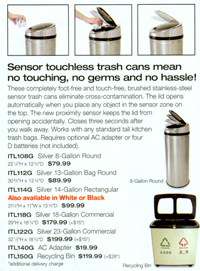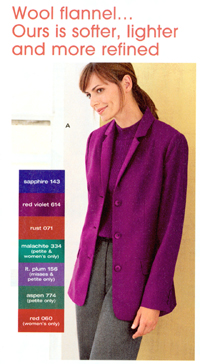
Twenty years ago, if you asked any successful cataloger to explain the creative difference between catalog copy and direct response copy, you’d quickly get a practical and usable answer.
Ask that question as we careen into 2009, and chances are high you’d get a puzzled look followed by “Well, the answer isn’t that simple.”

It isn’t simple, because natural evolution and the invasion of the World Wide Web — with both its cosmic effect on attention spans and its universally competitive ambiance — have blurred or eliminated the differences between most force-communication media. Today’s successful catalog cannibalizes sales from other media, just as other media cannibalize sales from the once-sacred catalog turf.
Repeat, on a copywriting level: Today’s successful catalog not only describes but generates the desire to buy.
An unanswered question and they’re gone
Skymall, the catalog in airline seat-pockets, should be the most savvy of the print catalog brotherhood because supposedly it’s the most serendipitous. The reader sees what he or she isn’t looking for, and competitors are side-by-side in a grab-now-or-lose-’em book that often approaches 200 pages.
Who picks up and reads this catalog? Just about everybody. So the creative team, looking for maximized response, has a problem not generic to catalogs as a whole: It must appeal to as broad a readership as possible without alienating the considerably narrower group, those who are pre-interested in a specific item.
Here’s an item in that catalog. The illustration is a golfer completing a swing. Above his head is a title, “Q-RAY®, What the Pros Know.” The heading: “A better looking swing. Guaranteed.”
The product seems to be a bracelet of the David Yurman type, although the golfer is wearing a wristwatch. Hmmm. Okay, how can a bracelet — assuming it really is a bracelet — guarantee a better looking swing? The text, in its entirety:
“For years, Q-Ray has been worn by professional golfers throughout the Tour. Wear a Q-Ray when you play your next round. One thing is certain: You’ll have a better looking swing.”
And that’s it, except for prices, ranging from $99.95 for “Silver Deluxe (with silver finish terminals)” to “Gold Deluxe (plated with real gold)” for $169.95.
Dismiss any preconceived prejudices and ask yourself whether this is the best way to sell whatever it is — which to us in this noble profession means, “Would you hire the writer?”
I wouldn’t. I wouldn’t hire whoever hired the writer.
Why? Because I sense neither clarity nor even mildly convincing salesmanship. And that deadly lack is, in a catalog whose products can’t regard themselves as presold, well, it’s deadly.
Keep your promise
This is the display type above a set of wool flannel coordinates: “Wool flannel… Ours is softer, lighter and more refined.”
Okay, that’s a promise, but it’s semi-specific. And semi-specific doesn’t match totally specific as a qualifier for creating a need. The reader asks: Softer, lighter and more refined than what? And define “refined.” The entire copy block, under the neutral heading “Wool Flannel Coordinates”:
“We tailor our classic coordinates from the finest worsted-wool flannel available. Exceptionally soft and lightweight, for a more refined look and smooth, streamlined fit, it’s also wonderfully warm. Fully lined. Dry clean. Imported.”
Workmanlike? Yes. Two problems: First, the big display type deals in comparatives. Soft, but the wording is “Softer” — than what? Unexplained. Light, but the wording is “Lighter” — than what? Unexplained. Refined, but the wording is “More refined” — than what?
Is this a big deal? Of course not. Is it less than optimal salesmanship? Oh, yes, it is. Add to that the deadly word “available” and we have a description that isn’t as competitive as it might be. And in what every knowledgeable commentator calls a “tough” holiday season, copy that isn’t competitive is considerably more damaging than it would be in kinder, gentler times.
The benefit of “benefit”
Stating a benefit automatically implies a need. It’s one of the most venerable and one of the most effective selling weapons, in print or online or in person.
We bought a trash can for our kitchen. It’s tall and round and stainless steel…and strange, because it has a lid that opens automatically when a hand or a bit of trash is placed near it.
Would we have bought that item if the catalog had described it as “Stainless steel trash can opens automatically”? Nah. We’d have flipped past it. But this was the arresting heading:
“Sensor touchless trash cans mean no touching, no germs and no hassle!”
Without the “germs,” that heading would have lost about half its impact. But the germs-reference was a grabber, and the body copy maintained the brisk pace, except for one redundancy:
“These completely foot-free and touch-free, brushed stainless-steel sensor trash cans eliminate cross-contamination. The lid opens automatically when you place any object in the sensor zone on the top. The new proximity sensor keeps the lid from opening accidentally. Closes three seconds after you walk away. Works with any standard tall kitchen trash bags. Requires optional AC adapter or four D batteries (not included).
What’s the redundancy? I’d have combined the second and third sentences into a single coherent statement.
Writing it that way isn’t tough
Create a need. State a benefit. Neither of those three-word imperatives is abstruse or complex.
So a commitment the dedicated professional catalog creative team should make, for 2009 and the immediate beyond, is to supply a clear and recognizable reason for buying.
Career salespeople know that. Successful career salespeople do that. And aren’t we supposed to be successful career salespeople?
Herschell Gordon Lewis is the principal of Lewis Enterprises in Pompano Beach, FL. Author of 31 books, including Catalog Copy That Sizzles, On the Art of Writing Copy, Marketing Mayhem, Effective E-Mail Marketing, Asinine Advertising and the recently published Creative Rules for the 21st Century, he writes copy for and consults with clients worldwide.